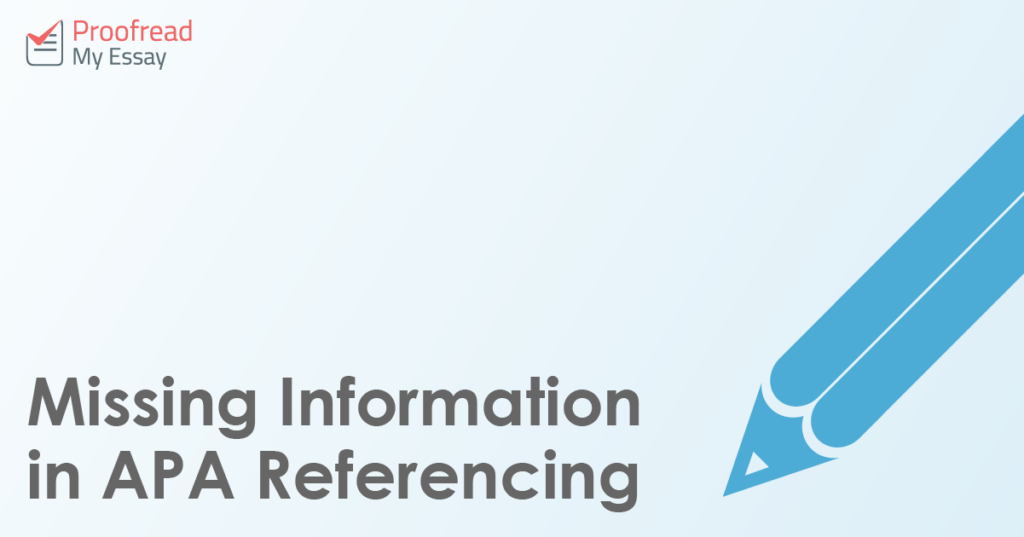Referencing can be tricky even when you have all the source details. But what should you do when you can’t find the author’s name or date of publication for a source? First of all, don’t panic! We’re here to help. In this post, we take a look at how to deal with missing information in APA referencing.

No Named Author: Organisational Authors
Not every source will name the person who wrote it. The best approach to use when this happens is to cite an organisational author (i.e. the company or organisation that produced the source):
Anonymity can affect the psyche over prolonged periods (American Psychological Association, 2008).
Here, for example, we cite the American Psychological Association. We would then use the same organisational author in the reference list:
American Psychological Association (2008). The psychological effects of anonymity on self-esteem. APA Press Inc.
If you cite a source like this more than once, you may also want to abbreviate the organisation’s name. You can do this within a citation by adding the abbreviation in square brackets:
Anonymity can affect the psyche over prolonged periods (American Psychological Association [APA], 2008).
On the next citation, you would then use the abbreviated form by itself.
No Named Author: Anonymous Authors
If a source truly has no author to name, APA style recommends using the title in place of a name for citations and the reference list.
If the title is quite long, you should also shorten it. For instance, we could cite an anonymous book called How to Cite Sources Effectively like this:
Citing sources can be difficult (How to Cite, 2001).
You would then use the source title in place of an author’s name in the reference list as well (the only time you should attribute something to ‘Anonymous’ is when the author is listed as such on the source). For example:
How to cite sources effectively. (2001). Proofed Books.
You’d also use the first word of the title when sorting sources alphabetically.
Find this useful?
Subscribe to our newsletter and get writing tips from our editors straight to your inbox.
Sources Without a Year of Publication
If you cannot find a date of publication for a source, you can use the phrase ‘n.d.’ in citations and the reference list instead (this is short for ‘no date’):
Time makes fools of us all (Smith, n.d.).
We would then also use ‘n.d.’ in place of a year in the reference list:
Smith, A. (n.d.). A book beyond time. Proofed Books.
Sources Without a Title
It is rare for sources to lack a title, but it can happen occasionally (e.g. for a painting or another work of visual art). In these cases, you can use a description in square brackets place of a title in references. For instance:
Kannaght, Y. (1989). [Finger painting of old lady in party hat]. The Museum of Bad Art, London, United Kingdom.
If the source lacks a named author and a title, you can use the description (or a shortened version of the description) in citations as well. However, make sure you’ve checked thoroughly for these details before leaving them out!
Sources Without Page Numbers
A common type of missing information is when a source has no page numbers, such as a website. In cases like this, APA suggests using a paragraph number or a subheading in citations instead:
Smith (2003) rejects the ‘need for page numbers’ (para. 6).
As a rule, paragraph numbers are most useful for shorter documents where you can quickly count the number of paragraphs therein (or for sources that come with pre-numbered paragraphs). For longer works without paragraph or page numbers in the text, you can cite chapter, section, or part numbers instead when available.
Summary: Missing Information in APA Referencing
If you cannot find full source information, APA referencing suggests citing:
- An organisational author if the source is missing a named author (or using the title in place of a name if there is no suitable organisational author).
- The abbreviation ‘n.d.’ if the source does not have a year of publication.
- A description in square brackets when a source has no title.
- Paragraph numbers if a source has no page numbers.
However, remember to check carefully before using any of these methods. Most sources will have these details available, even if they are not always easy to spot at first.



